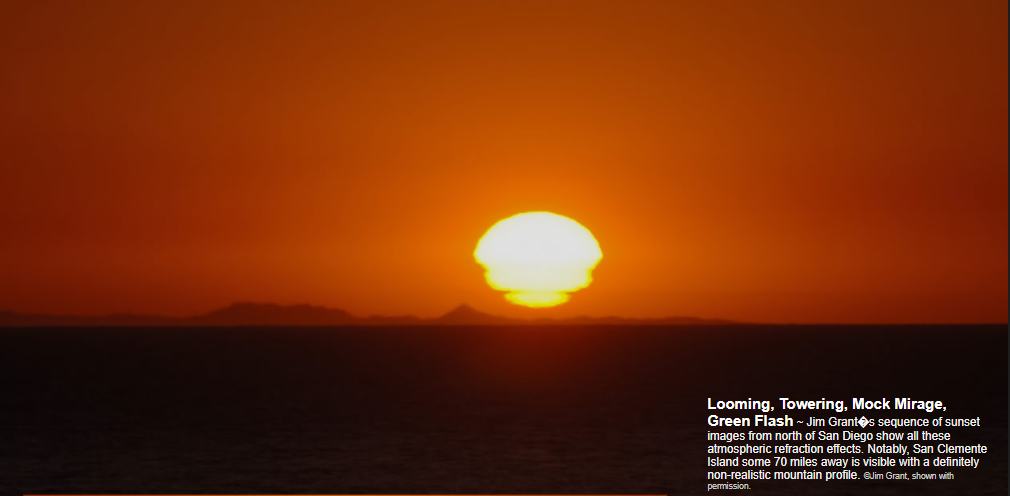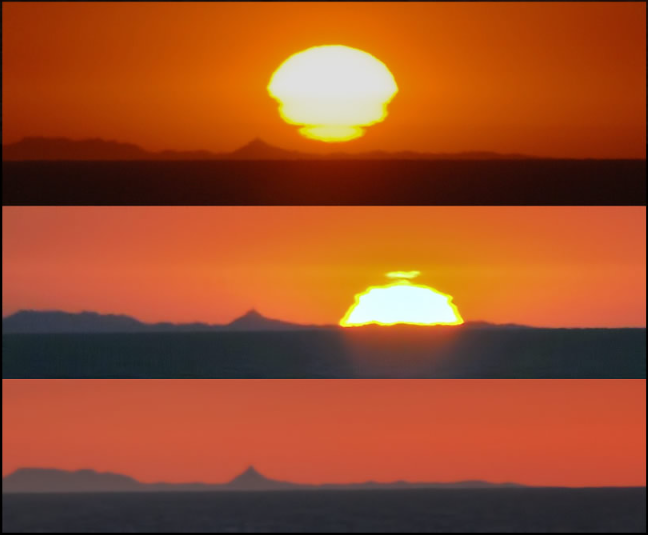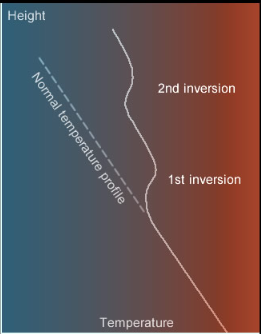OPOD - Looming, Towering, Mock-Mirage, Green Flash
OPOD - Looming, Towering, Mock-Mirage, Green Flash: A Detailed Exploration
Atmospheric refraction can create fascinating optical phenomena, as captured in Jim Grant's sequence of sunset images from north of San Diego. These images showcase a range of effects, including looming, towering, mock mirages, and the elusive green flash. By understanding the underlying principles of refraction, we can unravel the mysteries behind these captivating phenomena.
The Distorted Sun and the Green Flash
In Grant's photographs, the distorted appearance of the sun and the presence of a green flash at its upper limb are both attributed to refraction caused by multiple stacked temperature inversion layers. These layers consist of kinks in the normal fall in air temperature with height, with warmer air situated above cooler air. Notably, there are at least two inversion layers at play here.
Looming: Objects Raised Above the Horizon
Looming is an age-old term used by sailors to describe the phenomenon where distant objects that should be below the horizon appear raised up. In the case of Grant's images, the visibility of San Clemente Island, located 70 miles away, can be attributed to relatively cool air beneath the lowest inversion layer. This cooler air, combined with a normal temperature gradient, causes the island to loom above the horizon.
- Looming raises distant objects above the horizon.
- San Clemente Island's visibility is due to cooler air beneath the lowest inversion layer.
- Looming does not distort objects; it simply raises them.
Towering: Distorted Images and Stretched Profiles
While looming raises objects without distorting them, something more intriguing is happening to San Clemente Island in Grant's photographs. The island's image appears distorted, with its peaks stretched vertically. Sailors referred to this phenomenon as towering. The distortion is likely a result of the lowest temperature inversion, which reduces or even reverses the vertical temperature gradient towards the top of the island profile. As a result, the island image is stretched more at its top than at its lower part.
- Towering refers to the distortion of distant objects caused by refraction.
- The vertical stretching of San Clemente Island's profile is a result of the lowest temperature inversion.
- Towering occurs due to more pronounced looming at the top of an object compared to its lower part.
Looming, Towering, and Mirages
While looming and towering are both distortions resulting from atmospheric refraction, they are distinct from mirages. Mirages require the presence of inverted or multiple images, which are absent in these phenomena. Therefore, the images captured by Grant exhibit the characteristics of looming and towering rather than mirages.
- Mirages require inverted or multiple images, which are not present in looming and towering.
- The absence of these characteristics confirms that Grant's photographs depict looming and towering.
Further Examples of Looming and Towering
The captivating images captured by Jim Grant are not the only instances where looming and towering can be observed. Additional photographs showcase these atmospheric refraction effects in different settings, providing further insight into their occurrence.
- Supplementary images demonstrate the widespread occurrence of looming and towering.
- These examples contribute to our understanding of the underlying principles behind these phenomena.
The Quest for the Green Flash
Among the various atmospheric refraction effects, the green flash stands out as a particularly elusive phenomenon. This optical phenomenon occurs during sunrise or sunset when a brief green light appears on the upper rim of the sun. While challenging to observe due to its fleeting nature, Grant's images offer a glimpse of this captivating event.
- The green flash is a rare optical phenomenon that occurs during sunrise or sunset.
- Grant's photographs capture the elusive green flash, offering a glimpse of its beauty.
Conclusion
Jim Grant's sequence of sunset images provides a captivating exploration of atmospheric refraction effects, including looming, towering, mock mirages, and the elusive green flash. By delving into the principles behind these phenomena, we gain a deeper understanding of the ways in which our atmosphere can distort and transform our perception of the world around us. These optical wonders continue to inspire awe and curiosity, reminding us of the intricate and mesmerizing nature of our atmosphere.

Looming, Towering, Mock Mirage, Green Flash ~ Jim Grant�s sequence of sunset images from north of San Diego show all these atmospheric refraction effects. Notably, San Clemente Island some 70 miles away is visible with a definitely non-realistic mountain profile. ©Jim Grant, shown with permission.
The distorted sun and the green flash at its upper limb result from refraction by several stacked temperature inversion layers � kinks in the normal fall in air temperature with height with abnormally warmer air above cooler. There are at least two inversion layers.
Looming is an old sailors' term. Distant objects that sometimes should be below the horizon appear raised up. Here the appearance of 70 mile distant San Clemente is due to the combination of relatively cool (and normal temperature gradient) air beneath the lowest inversion layer.
Looming does not distort a distant object, it merely raises it. But something more is apparently happening to San Clemente because the island does not have such steep conical peaks! Sailors called this towering. The island image is distorted - stretched vertically. The towering is probably a result of the lowest temperature inversion which reduces or even inverts the vertical temperature gradient towards the top of the island profile. In effect the island image is stretched by more looming at its top than at its lower part.
Looming and towering are distortions from atmospheric refraction but not mirages. They lack the inverted or multiple images necessary for them to be called mirages.





More looming & towering


Note: this article has been automatically converted from the old site and may not appear as intended. You can find the original article here.
Reference Atmospheric Optics
If you use any of the definitions, information, or data presented on Atmospheric Optics, please copy the link or reference below to properly credit us as the reference source. Thank you!
-
<a href="https://atoptics.co.uk/blog/opod-looming-towering-mock-mirage-green-flash/">OPOD - Looming, Towering, Mock-Mirage, Green Flash</a>
-
"OPOD - Looming, Towering, Mock-Mirage, Green Flash". Atmospheric Optics. Accessed on December 22, 2024. https://atoptics.co.uk/blog/opod-looming-towering-mock-mirage-green-flash/.
-
"OPOD - Looming, Towering, Mock-Mirage, Green Flash". Atmospheric Optics, https://atoptics.co.uk/blog/opod-looming-towering-mock-mirage-green-flash/. Accessed 22 December, 2024
-
OPOD - Looming, Towering, Mock-Mirage, Green Flash. Atmospheric Optics. Retrieved from https://atoptics.co.uk/blog/opod-looming-towering-mock-mirage-green-flash/.